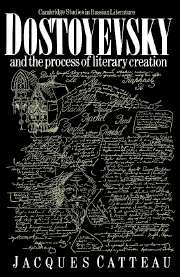Book contents
- Frontmatter
- Contents
- Preface to the English edition
- List of abbreviations
- General editor's note on transliteration and references
- General introduction
- PART I The creative environment
- PART II The process of creation
- Introduction
- 7 The writer at work
- 8 The great dialogue: the news item
- 9 The great dialogue: migrant images
- 10 The play of dialogue
- 11 The unity of thought in the novel
- 12 The summit of creative interrogation: ‘The Life of a Great Sinner’
- 13 A Raw Youth: reasons for choice
- 14 A Raw Youth: the appearance of the vision
- 15 A Raw Youth: the human architecture
- 16 A Raw Youth: the Idea of the novel
- 17 The composition of the novel in Dostoyevsky's work: choice of chronicle form
- 18 Composition of the novel in A Raw Youth: chronicle and stories
- Part III Time and space in the world of the novels
- Conclusion
- Notes
- Select bibliography
- Index of names
14 - A Raw Youth: the appearance of the vision
Published online by Cambridge University Press: 18 December 2009
- Frontmatter
- Contents
- Preface to the English edition
- List of abbreviations
- General editor's note on transliteration and references
- General introduction
- PART I The creative environment
- PART II The process of creation
- Introduction
- 7 The writer at work
- 8 The great dialogue: the news item
- 9 The great dialogue: migrant images
- 10 The play of dialogue
- 11 The unity of thought in the novel
- 12 The summit of creative interrogation: ‘The Life of a Great Sinner’
- 13 A Raw Youth: reasons for choice
- 14 A Raw Youth: the appearance of the vision
- 15 A Raw Youth: the human architecture
- 16 A Raw Youth: the Idea of the novel
- 17 The composition of the novel in Dostoyevsky's work: choice of chronicle form
- 18 Composition of the novel in A Raw Youth: chronicle and stories
- Part III Time and space in the world of the novels
- Conclusion
- Notes
- Select bibliography
- Index of names
Summary
The poet is truly the thief of fire. He is burdened with humanity, even with animals; he will have to make his inventions feel, sense, and hear; if what he brings from out there has a form, he gives it a form; if it is formless, he gives the formless.
Arthur Rimbaud, Letter to Paul Demeny, 15 May 1871For Dostoyevsky, the urge towards a new novel always began with vast and laborious rumination. Themes and characters from earlier works which he had failed to exorcise returned, accompanied by even more demanding themes and characters from the underground creative stream, of which ‘The Life of a Great Sinner’ is the boldest vision, all impetuously clamouring for life.
The new novel began by exploding other novels and gathering them together in one gigantic puzzle, into which unpublished pieces, prophetic of later works, tended to glide surreptitiously. This was not a mechanical process; it was the appearance of a whole universe. Like the poet Rimbaud, Dostoyevsky brings the formless back from his rumination. The unity of the work and the continuity of the creative interrogation are inscribed at the beginning of the notebooks, where identifiable relics from earlier works and the meteorites of future ones are crushed together. The novels of Dostoyevsky have an epilogue only for the reader, never for the writer, who is constantly deepening and resurrecting people he has killed or doomed to oblivion.
The fantastic novel-poem
The Devils, the satirical novel which caused Dostoyevsky to postpone his grandiose design of ‘The Life of a Great Sinner’ indefinitely and left it bloodless, reappeared in the very first lines of the notebooks of A Raw Youth.
- Type
- Chapter
- Information
- Dostoyevsky and the Process of Literary Creation , pp. 262 - 271Publisher: Cambridge University PressPrint publication year: 1989



